More from Albert Breer: The Bengals Are Much More Than Just Joe Burrow | Commanders, Vikings Survive Week of Difficult Tests | Roquan Smith Is Unlocking What It Means to Be a Raven
What a fun Sunday of professional football that was. Let’s waste no time diving in …
The Eagles’ win over the Cowboys was yet another example of how to build a winning team the right way. I’m sure people will look at another blood-and-guts effort from Jalen Hurts, or A.J. Brown’s continuing to produce (though he fell below 125 yards for the first time since Week 2), or at some of the timely plays a resourceful Eagles secondary made Sunday, and tell the story of Philly’s 28–23 win over Dallas through that prism.
Rightfully so. All those factors played into Sunday’s drama.
But to me, and the Eagles themselves, none loomed larger than the core of how this Philly team, and so many of its predecessors, was put together: Every element of that build starts at the line of scrimmage.
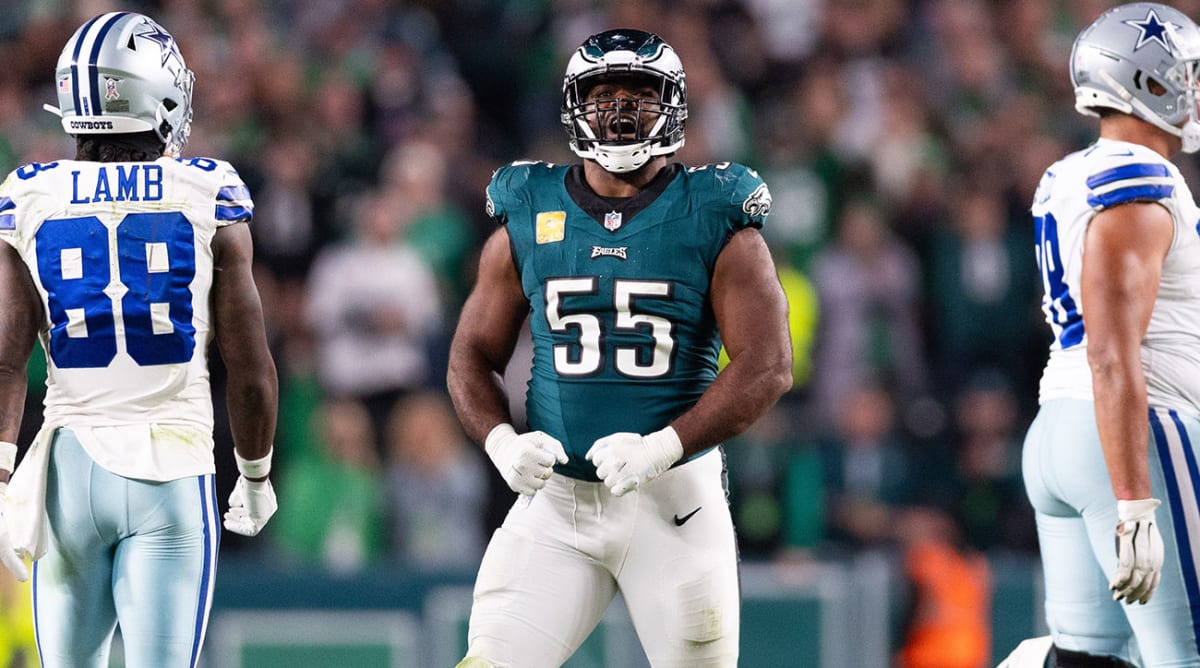
Bill Streicher/USA TODAY Sports
“I love the way [GM] Howie [Roseman] put together this team,” 14th-year defensive end Brandon Graham told me postgame. “The biggest thing is keeping us healthy, keeping the rotation good and keeping us fresh as we go, especially as a D-line because our rotation is big. We got people that could be starters other places that are coming off the bench. That’s what I love. We got a bunch of hungry guys, especially me, enjoying my role that I know that every rep counts when I’m out there.
“I’m just thankful for that and appreciative of whenever I’m in, I’m always trying to make it count. That’s what I talk about with [rookie] Nolan [Smith], with me and him being together—just make it count.”
Sure enough, a lot of guys on that deep defensive front made it count at the wire Sunday.
First, there was the stand at the beginning of the fourth quarter, with the Eagles’ getting four straight stops in a goal-to-go situation, with pressure on Dak Prescott forcing the throw to Luke Schoonmaker a bit outside, which had the tight end lunging for the ball and leaving him unable to flash it past the goal line (Reed Blankenship rode him to the ground just shy).
Then, an in-game adjustment paid dividends. Graham had noticed the Cowboys were doing what the Packers used to with Aaron Rodgers, in getting Jalen Hurts to more aggressively climb the pocket, and get through the B gaps to use Philly’s aggression against the Eagles. So he started doubling back inside on his rush to catch Prescott before he could get away.
The sacks would follow. After a Dallas score cut the Philly lead to 28–23, the Eagles got two in a row—the first by Graham, the second split between Graham and Jalen Carter—to put Dallas in third-and-21 and ultimately set the stage for a turnover on downs. Which, to the dean of the Eagles’ roster, reflected how his unit is working together.
“It was just more about trust that we have for each other, the respect that we have to be able to talk to each other in pressure moments where things aren’t going so right, but we just need somebody to make a play and calm people down,” Graham says. “It’s so much stuff that goes into it. Some people can be frustrated with other guys’ not doing their job. We don’t do that. If we do, the person that is going off, check yourself. It can’t be perfect.”
But it was when it needed to be, and on this night that juncture came with 27 seconds showing, and the ball on the Eagles’ 11. Josh Sweat came screaming off the left edge and right tackle Terence Steele, riding up on a player he knew was trying to push him past the quarterback, then bending and closing on Prescott.
“For Sweat to come out, he just seen me do it, he went to that side on Steele and, boy, you get smart matchups,” Graham says. “He knew that he only had so many seconds before Dak got rid of it. I think it was just cool to see him make his play. I just know as a D-line, it’s about us rushing together, rushing cohesive.”
And it’s about the Eagles’ being loaded there like they are on the offensive line, which is the basis for how Roseman’s put the whole thing together for years.
So go ahead and fawn over the receivers or DBs all you want.
Sunday showed, again, where the foundation for this 8–1 powerhouse is laid—and why the team will remain a powerhouse for the foreseeable future.
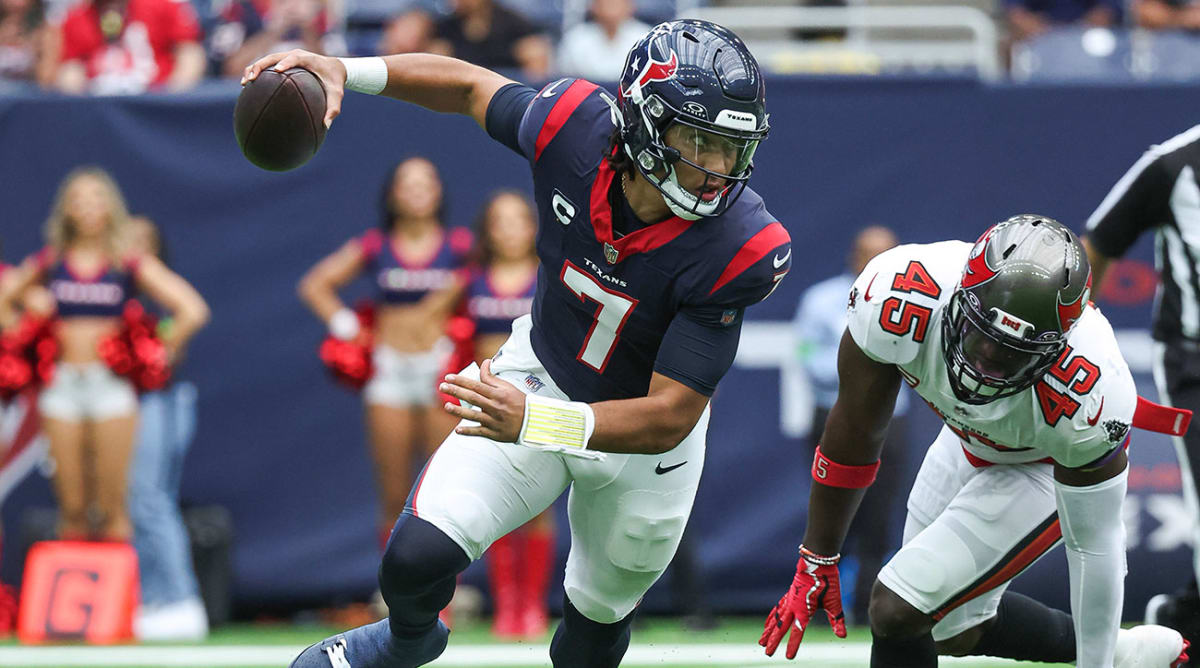
Troy Taormina/USA TODAY Sports
The Texans have a rookie quarterback who’s playing at a ridiculous level. And while what C.J. Stroud did Sunday against the Buccaneers, in breaking the NFL’s single-game rookie passing yardage record, was jaw-dropping for the rest of us, his rookie classmate Tank Dell swears he wasn’t all that surprised by how it played out.
To review, Stroud drove the Texans’ 64 yards for a 29-yard, go-ahead field goal from (yes) reserve tailback Dare Ogunbowale, then, somehow, covered 75 yards in six plays in the game’s final 46 seconds to give the upstart Texans a 39–37 win over the Buccaneers.
“That man has the it factor,” says Dell, who made big catch after big catch for Stroud. “And when I say it factor, it’s just the one that the world’s seeing now. We know. He does stuff like that in practice when we practice in two-minute all the time. The confidence that he has in himself, how he carries himself with that swag … it just translated to the game.”
It’s translated all year of course—but never yet like it did Sunday.
Stroud finished 30-of-42 for 470 yards, five touchdowns, no picks and a 147.8 quarterback rating. The key, really, was how he capped that over the back half of the ballgame. And Stroud’s heater started with a couple of long touchdown throws, one in which his receiver did most of the work, and the other where it was largely the quarterback himself.
The first had Stroud finding his fellow former Ohio State star Noah Brown on a crosser, which Brown would turn upfield for a 75-yard touchdown. The second was an absolute dime—a bomb he threw flat-footed from the pocket, after taking a deep drop, to the back corner of the end zone. Equally remarkable? That in his eighth NFL start, it was the result of an on-the-fly adjustment Stroud made based on the coverage Houston was getting.
“I was supposed to have a curl, but C.J. told me as I was leaving the huddle … he was like, Pump it,” Dell says. “I went out there and I did exactly like he said. He threw a great ball, didn’t have to do too much. I just had to run a nice route, and he put it right on the money where it’s supposed to be. I can’t take the credit for that one. C.J., he’s a ballplayer.”
Then, there were the two connections he and Stroud hooked up for when it really counted.
Baker Mayfield drove the Buccaneers 61 yards in 10 plays in the game’s waning moments, to put Tampa Bay up 37–33—and leave Houston with just 46 seconds to work with. Stroud promptly hit Dalton Schultz twice for 20 yards, and the Texans burned both their timeouts, with the ball at their own 45. Stroud then hit Brown for another 14 yards to get the Texans to the Tampa 41, where he spiked the ball.
That’s where offensive coordinator Bobby Slowik called a play to try to catch the Bucs being a bit lackadaisical on the backside of plays and find a dead spot in the coverage.
“It wasn’t too much time on the clock, so they were trying to play a little off coverage,” Dell says. “It was just getting to that sweet spot in the defense. I had a hitch route, 20-something-yard route to the sideline. When I came out of my break, I saw the ball coming. Like I said before, it was just C.J. putting the ball right on the money, and I just got my feet down.”
That accounted for 26 yards, with Dell catching it hard by the sideline, and dragging his feet in, while going out, to stop the clock with 10 seconds left. On the next play, Stroud didn’t hesitate, confidently delivering a rope down Main Street to Dell on the post for the win, from 15 yards out.
“Shouts out to coach Slowik dialing the play up,” says Dell. “That’s one of our old plays that’s from OTA one install. That’s just one of my red zone plays. It’s a post in the end zone, like five yards into the end zone. Me and C.J. just had that connection. The O-line, for sure. held up. Noah took some people with him because Noah was definitely going crazy this game. They kept an eye on Noah. And then it was just the route thrown out with me and C.J. just going out there to execute the play.”
Of course, Stroud and Dell did a lot more than just that on this day.
This was another one of a few this fall, where it sure felt like Stroud, Dell and new coach DeMeco Ryans have managed to pump life into a franchise that’s flat-lined through the last three years. And it’s Stroud more than anything, in part because of the position he plays, but also because of who he is.
“With him, we’re never out of the game,” Dell says. “All we got to do is just believe in him. He believes in us, for sure. But just keep believing in him, believe in the play call and go out there and play ball. There’s no worry with C.J. because he’s going to fight all four quarters, no matter what the score is, no matter what’s going on in the game, how the game’s going. He’s going to be there all four quarters and he’s going to let you know that he’s got us.”
He most certainly had them, and the Bucs, on Sunday.
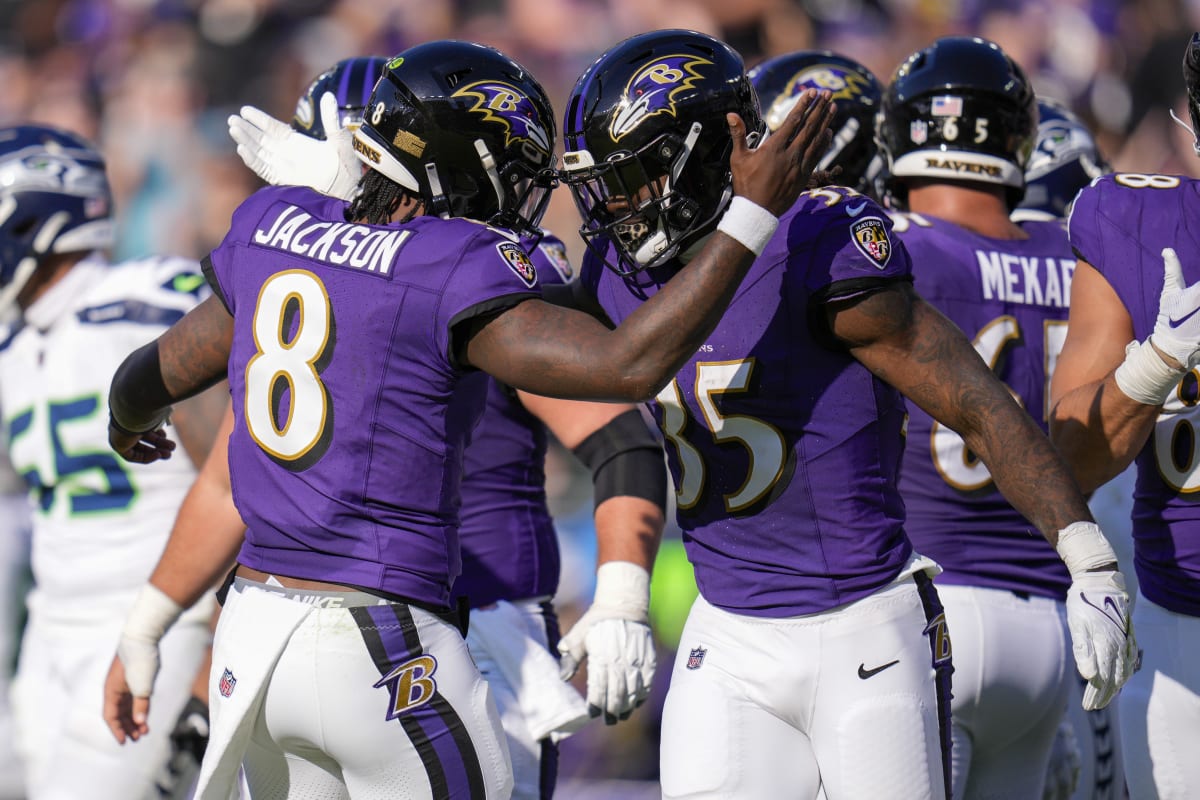
Jessica Rapfogel/USA TODAY Sports
To me, the Ravens have the two best wins of the season. And that’s not just about who they came against—though the fact that they were over the Lions and Seahawks counts for plenty. It’s also about just how thorough the beatings were, the former coming by a 38–6 final, while the latter was 37–3, with both of Baltimore’s opponents being bludgeoned to the point where the games were never really competitive.
Oh, and the other thing about all this? The Ravens seem to be well aware you’re not talking about them, despite just how they’ve arrived at 7–2 through nine games.
“Honestly, man, as I think about it, we just playing our style,” linebacker Roquan Smith, traded to Baltimore a year ago last week, told me. “And I feel like when we play our style and we’re at home, we’re very hard to move the ball on. Last week with Arizona, we didn’t play to our standard, we felt like, as a defense. So we was definitely pissed off coming into this week, and just knowing how people were saying Seahawks this, Seahawks that—we take those things personal.
“And at the end of the day, we just knew if we come out and play our style, that it’s gonna be very hard for that team to move the ball on our defense.”
The Ravens’ style Sunday looked very similar to how a lot of dominant Baltimore teams have played over the years, and, again, how it looked two Sundays ago against Detroit, too. Consider:
• In Baltimore’s 38–6 win over Detroit, the Ravens outgained the Lions 503 to 337, and had 23 first downs to their visitors’ 18. But the counts were 459 to 215 and 21 to 10 at the end of the third quarter. The score at that point was 35–0. The Ravens’ first punt in the game came after Baltimore got that five-touchdown lead.
• On Sunday, it was even more lopsided. The 34-point win over Seattle was highlighted by a 515-to-151 edge in yards and a 29 to six advantage in first downs. The Ravens also had more than 40 minutes of possession, and rushed for 298 of their yards, at a 7.3 yards per carry clip.
And, if you hear Smith tell the story of it, what happened in between those two games was a factor, too.
Yes, the Ravens won last week in Arizona. But, according to Smith, “We didn’t play to our standard.” Mostly, he continued, the fourth quarter was the problem—Baltimore led 24–7 with less than 10 minutes left, before allowing twin 75-yard touchdown drives, then a late field goal that made it a one-score game with 26 seconds left.
“Thinking about that, and knowing we have a mentality as being closers, and knowing that we want to close out games, we feel like we didn’t do that last week,” Smith says. “So we definitely took it personal all week long.”
It worked, of course, just as had the chatter about Seattle’s reemergence as a top contender, without much mention of the rolling Ravens team that the Seahawks were faced with. So this time around, the Ravens allowed two first downs, 50 yards, and no points in the fourth quarter to slam the door shut and send Seattle back across the country.
And in doing so, similarly to how they choked the Lions out Oct. 22, they sent a pretty distinct message to the rest of the league. The Ravens will be heard from, whether you’re choosing to listen at this point.
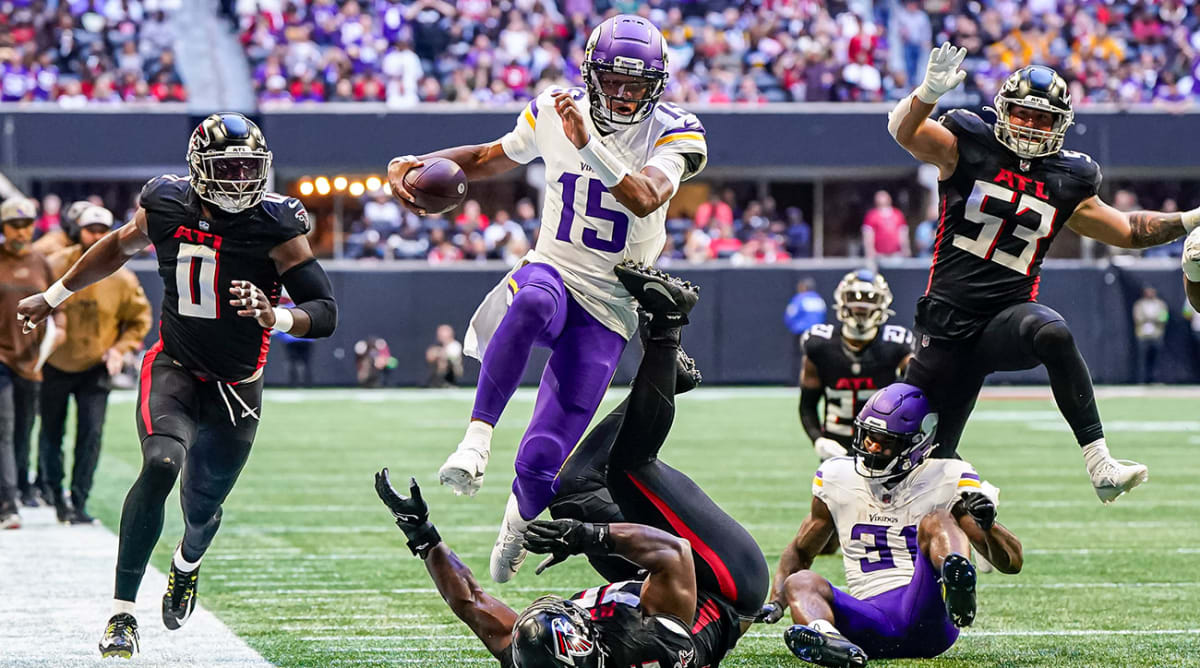
Dale Zanine/USA TODAY Sports
Joshua Dobbs deserves his five minutes here. And to kick those five minutes off—in light of his ability to lead the Vikings to a 31–28 win in Atlanta on his fifth full day with the team—I figured I’d pose a simple question to his coach, Kevin O’Connell, who was once an NFL quarterback himself.
What exactly did it take for Dobbs to pull off what he just pulled off?
“I would say you need to have composure; you need to be intelligent,” O’Connell told me, from the tarmac at Hartsfield. “And beyond all that, I mean I was talking to him a lot, to be able to digest the information that I’m giving to him in real time, and be able to function and still go play quarterback, some of the plays he made, some of the throws he made means doing it all for the first time in an NFL game, on the road against a really good defense … that’s the reason why Josh was one of those guys that I immediately … it hit my brain to get him.
“I didn’t know he’d be available, and then [the Cardinals] made that move [to bench him] and I was like, This is a guy. I just wanted to see him around this team in this locker room, be able to coach him, be able to call plays for him and see if we can potentially put him in a great situation and then let him just go play.”
O’Connell laughed a couple of minutes later in giving himself the reminder—“I’ve only known him really for about five days.”
Somehow, those five days were enough for the whip-smart Dobbs—once an aerospace engineering major at Tennessee—to assimilate into an offense he’d never played in, with a coach he’d never played for, with teammates he’d mostly never met before, and throw for 158 yards, two scores and a 101.8 passer rating on 20-of-30 passing in Kirk Cousins’s place.
How he, and the Vikings made it happen is pretty interesting. And there were a few elements to getting it done.
One was that O’Connell knew coaching concepts over play calls would be key, since force-feeding Dobbs an entire new language in such a short window would be important. So, O’Connell said, he’d take the “concept understanding, and then it’s just the nuances of the play, where I can then give him a little point here and there based upon on how the game was going, what coverages we were seeing and kind of, Hey, if they do this, do this.”
Which flowed right into the second point, and that was, for O’Connell, that, “I just kept reminding him, Don’t forget about your legs.” Dobbs didn’t as the game went on—using his ability to run to, to borrow O’Connell’s phrase, “resolve conflict.” And never more so than on a fourth-and-7 on the game-winning drive, on which Dobbs stepped up to avoid the rush, slipped one guy in the process, then made three more miss in picking up 22 yards.
Then, for coach and quarterback, there was an old trick to use every second on the headset available—right up to the mandated cutoff when the play clock hit 15 seconds. O’Connell tried to be selective in choosing what information to give him, as to not clutter things up, and might have been most effective when it mattered most, on the Vikings’ last offensive snap of the game.
The Vikings called a timeout first, which reset the play clock and allowed for the offense to go right to the line, and gave both coach and quarterback 25 seconds to diagnose what the Atlanta defense was bringing and how to attack it. “It was probably the most time throughout that whole drive that I could talk to him just because of how the sequence played out,” O’Connell says. “And I mean, he did it.”
It was throwing a four-yard touchdown pass to journeyman receiver Brandon Powell, a play that O’Connell said was Dobbs’s “best rep of the day.”
“It’s a slow read passing,” O’Connell continues. “It requires details with your feet and your eyes and your understanding of what we’re trying to attack, how your feet and eyes work together to help that happen, and then to trust in it—despite never having a single rep doing it before in this system.”
We’ll cover where the Vikings are taking things from here a little more in The MMQB Lead on the site Monday. But for now, it’s plenty to know that what Dobbs pulled off Sunday was pretty bananas, especially after he did something similar a couple of months ago in Arizona.
And from here, it’d stand to reason that, a week after losing Cousins for the season, and now at 5–4, Dobbs has managed to give the team a little more than it might’ve had otherwise.
The Chiefs are being carried by their defense, for once. Patrick Mahomes called it the best defense in the league to ESPN’s Jeff Darlington on the field postgame—and he might be right. Steve Spagnuolo’s crew went to Germany as the fourth-ranked defense in football and came back having held the mighty Dolphins offense to just 292 yards and 14 points.
It happened, really, because of how Spagnuolo’s vision for the group is matching what he’s getting from GM Brett Veach and the team’s scouts.
Perhaps the best example of it is at corner. L’Jarius Sneed, once seen as more strictly a slot corner, now isn’t just good enough to move around—on Sunday, he was trusted to the point where the Chiefs had him travel with Tyreek Hill. The Dolphins’ dynamo, of course, still got his, because he gets his on everyone. But the damage was limited to 62 yards and no scores, on eight catches, with a long of 19 yards.
Sneed’s ability to do that, in turn, freed the Chiefs up to use star sophomore Trent McDuffie every which way, lining him up in the slot, as a blitzer, and generally making sure he found a way to be disruptive. He certainly was at the end of the second quarter, in blowing up an attempted screen to Hill, jarring the ball loose. Safety Mike Edwards would collect it, then pitch it to Bryan Cook, who took it 59 yards to the house for a touchdown.
That made the score 21–0 at the half. And in a game that ended up 21–14, those points wound up being the decisive ones.
But the Sneed-McDuffie game-plan dynamic did more than win the Chiefs a critical AFC game. It also illustrated how, again, Spagnuolo’s vision to have smart, tough, versatile pieces he can move around like queens on a chess board is coming to life.
Linebackers Willie Gay Jr., Drue Tranquill and Leo Chenal can be swapped and moved around. Chamarri Conner can play safety and corner either inside or outside, which only adds to the malleability McDuffie and Sneed are bringing. Justin Reid is a safety, who can move down and be a nickel linebacker. Mike Danna and Charles Omenihu are ends who can kick down and play tackle, Chris Jones is a megatalent at tackle who can play end.
The bottom line is all of it adds up to Spagnuolo’s having maximum flexibility to move guys around and play them in different spots, and that’s a big reason why the defense he has now may be playing at the highest level of any he’s had in Kansas City. And why the highly potent Dolphins had such a hard time Sunday in Germany.
Joe Burrow is close to 100%, so look out, world. Here come the Bengals. They’re now 5–3 and playing like a team that’s 8–0. And all of it relates back to the quarterback who’s been all-world the last two years and now, with his calf healing, is playing like an all-planet player again.
In the first quarter Sunday night against the Bills, Burrow was 11-of-14 for 114 yards and a touchdown, and he engineered touchdown drives of 76 and 69 yards. For the evening, he wound up with 31-of-44 for 348 yards, three touchdowns and a 108.9 rating. So with all that in the books, and now consecutive games where he looked clean, and found a way to beat two of the best teams in football, the 49ers and Bills, I figured the time was right to ask Zac Taylor whether his quarterback is now all the way back.
“It feels like it,” Taylor said, after the 24–18 win. “I never like answering that question for the guys. But he certainly has made plays with his feet that have enabled us to continue drives and make some good plays. So that’s all we can ask for.”
Indeed, Burrow’s running to extend plays and pick up first downs, and doing everything we’ve become accustomed to seeing him do. Which means I, at least, am getting close to the point where I don’t feel the need to ask about the calf much anymore.
Which is a pretty good indicator that, when we do our midseason picks this week, I probably shouldn’t back off my preseason feeling that Cincinnati would win its first Super Bowl.
The race for the No. 1 pick is beginning to coalesce. Thanks to Tankathon.com, we have a pretty cool resource out there that does the tiebreakers for us year-round and tells us who’d be drafting where if the season ended today.
So here’s what we’re looking at through Sunday night …
1. Cardinals: 1–8
2. Bears (from Panthers): 1–7
3. Bears: 2–7
4. Giants: 2–7
5. Patriots: 2–7
6. Rams: 3–6
7. Packers: 3–5
8. Buccaneers: 3–5
9. Broncos: 3–5
10. Titans: 3–5
As of right now, I’d give USC QB Caleb Williams to Arizona at No. 1, North Carolina QB Drake Maye and Ohio State WR Marvin Harrison Jr. to the Bears at Nos. 2 and 3, Alabama pass rusher Dallas Turner to the Giants at No. 4, and Penn State OT Olu Fashanu to the Patriots at No. 5.
That said, as we’ve written, there were six quarterbacks who were raised to me by scouts as having a shot, outside or not, of making it into the first round, apart from Williams and Maye—Michigan’s J.J. McCarthy, Washington’s Michael Penix Jr., Oregon’s Bo Nix, Texas’s Quinn Ewers, Duke’s Riley Leonard and Colorado’s Shedeur Sanders. And with the benefit of a couple more recent conversations, I’d throw LSU’s Jayden Daniels in that bucket, too.
Anyway, it should be a blast to follow where all this goes in the weeks to come.
Speaking of that …
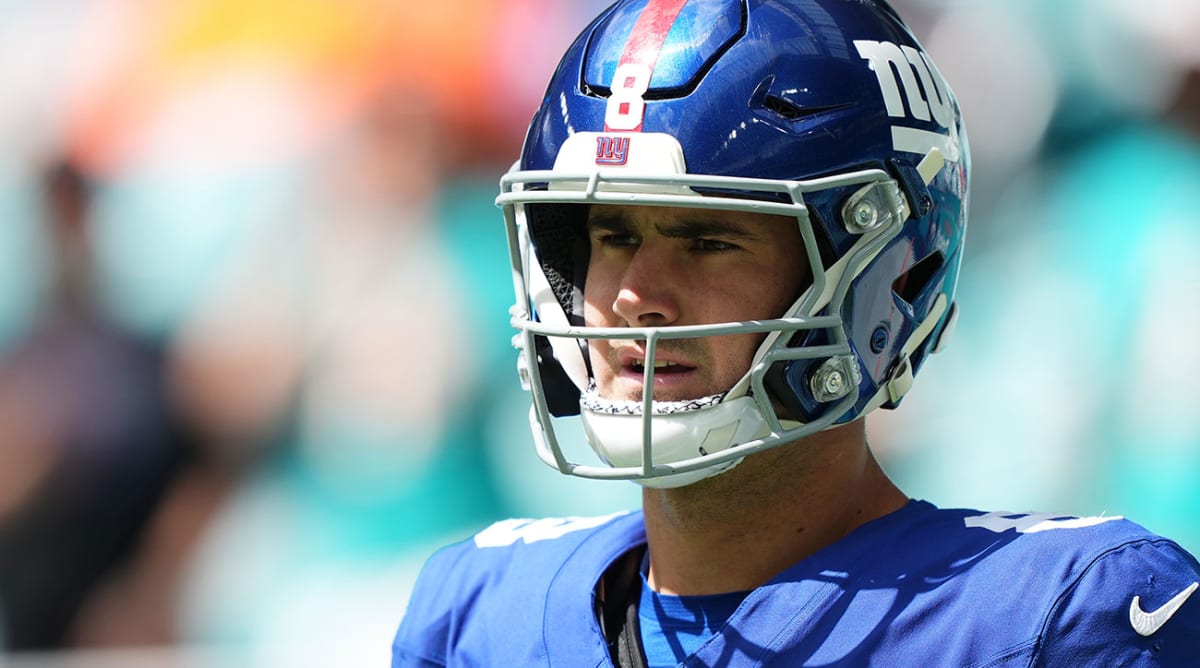
Jasen Vinlove/USA TODAY Sports
I feel terrible for Daniel Jones, but it might be time for the Giants to put their foot on the accelerator in the aforementioned race. While the fact that New York’s 26-year-old quarterback will likely have a torn ACL confirmed by MRI Monday morning really sucks, it does open the possibility for Brian Daboll and Joe Schoen that they’ll wind up in striking distance to land the kind of quarterback they can build around for a decade.
And those two were in Buffalo for the good chunks of the 16-month road the Bills drove through to land Josh Allen in April 2023. They know what it looks like to get that right.
So with Jones almost certainly gone for the year, and Tyrod Taylor on injured reserve for the next three weeks, at least, it’s easy to look ahead at a similar opportunity unfolding for the Giants’ coach and GM. New York has trips to Dallas and Washington next, then a home date with the Patriots for the Sunday after Thanksgiving, then the bye. If the Giants are 2–10 by then, it might make sense to slow-play any potential return of Taylor, and try to get some younger players some playing time, and let things play out naturally that way.
To be clear, I’m not advocating tanking for anyone.
I’d just call this sort of thing creative roster management.
And a means to an end (which I’d probably apply to the Cardinals, Bears and Patriots, too, given the level of quarterback prospects that should be available).
The Raiders’ win over that Giants team does count for something—even if it did come with whatshisname playing quarterback for New York. Why? Well, assuming this is more than the usual dead cat bounce (I’m borrowing that phrase from my buddy/colleague Tom E. Curran) of a team that just started working under a player-popular interim coach (the 2022 Colts beat the Raiders and lost to the Eagles by only a point in their first two games under Jeff Saturday), what Antonio Pierce is able to get out of the Raiders could color how Mark Davis approaches a lot of things going forward.
Of course, first and foremost, Las Vegas running off wins could get Pierce the head coaching job full time, especially at a point when others look back and wonder whether Mark Davis should have just elevated the interim coach (Rich Bisaccia) last time they were in this situation.
But even if Davis doesn’t, reeling off wins like Sunday’s 30–6 blowout of the Giants, would have an effect, in several ways.
First, it could validate the feeling some had in the building that Josh McDaniels was too hesitant to play younger players. One obvious example is Aidan O’Connell, whom many believed should’ve started in Chicago two weeks ago (McDaniels’s starting Brian Hoyer was one of the final straws), and who went an efficient 16-of-25 for 209 yards Sunday. But there were others, too. Tre Tucker, who reeled in a 50-yarder from O’Connell against the Giants, is one. Tyree Wilson, who had a sack on Tommy DeVito, is another.
Second, it could make the job itself, in what should be a crowded market, more attractive to potential candidates. The fact is, working for Davis is going to scare some people off, maybe even more so with McDaniels having lasted only 25 games. So at least creating the appearance that the team is closer than the general public might think would probably help with candidates like, say, Jim Harbaugh or Ben Johnson, who may have multiple options.
Third, it could change how Davis sees the hiring process in general. Would he hire an experienced hand because he thinks he’s close, and decide not to just go with Pierce? Would he keep other parts of the football infrastructure in place, because the team they built is performing?
All are fair questions to ask, and obviously plenty more are coming in the weeks and months ahead.
But for now, they can wait. Because if Sunday’s any indication, this Raiders group just got a lot more fun to watch—and has even more drama and intrigue around it than it did before.
We’ve got half the season down, and I have some quick-hitting thoughts to send you into your Mondays, with Jets-Chargers on tap to close out Week 9. Here … you … go …
• The Saints deserve some credit. They’re 5–4. They’ve got a raft of proud old veterans (Derek Carr, Alvin Kamara, Michael Thomas, Cam Jordan, Tyrann Mathieu, etc.). They’ve got rising young stars (Chris Olave, Rashid Shaheed). They’re resourceful (they won the turnover battle 5–0 on Sunday), and creative (they’ve gotten better at using Taysom Hill). And in a weakened NFC, maybe, just maybe, they’re a little dangerous.
• The Patriots are now a game and a half behind the next worst team in the AFC (a tie between the Titans and Broncos), and they’re about to go to Germany to play a feisty Colts team, which should be a very good test of how locked in the locker room is right now. Recent signs would say it’s not very, after the team has gone 5–12 in its last 17 games. New England, for what it’s worth, is now 27–32 (27–33 including playoffs) post–Tom Brady, with one playoff appearance (the Patriots lost by 30 to Buffalo in that one appearance).
• Shout-out to Ron Rivera and the Commanders for riding out a win in Foxborough on Sunday after trading away edge rushers Montez Sweat and Chase Young. That’s a tough spot for any coach or locker room, and Washington got the 20–17 win after blowing a 10–0 lead, and after Sam Howell threw a bad pick in the end zone to end the first half. All of it was good to see, because it shows that what’s been built there the last four years is actually relatively sturdy. We’ll see how much longer it holds up.
• The bottom seems to be falling out on the Rams, and that’s usually what happens with teams that are carrying as much dead money ($74 million) as Los Angeles is this year. Generally, in these spots, depth eventually gets stressed, and that’s where you really feel the pinch. Hence, a very ugly 20–3 loss at Lambeau.
• Nice bounce back for Jordan Love, who finished 20-of-26 for 228 yards and a touchdown in that win against the Rams. The Packers are smart in being patient with him. Remember, Aaron Rodgers went 6–10 his first year starting and halfway through his second year was 10–14. From there? Well, from there, the 2009 Packers rallied to make the playoffs, and the ’10 Packers won the whole thing.
• The attention was on C.J. Stroud in Houston and rightfully so. But Baker Mayfield played really, really well too, and that shouldn’t be lost in the (justifiable) hysteria over the Texans’ rookie.
• The Colts are super competitive week to week, and Shane Steichen’s having vets like Kenny Moore II is a pretty big reason why. Moore wound up with 115 return yards on two pick-sixes Sunday against the Panthers, which is how you have a quarterback throw for 127 yards, your team rush for 78 yards and still win the game by two touchdowns.
• Bryce Young picked a bad day to throw three picks, post a 48.3 quarterback rating and lose at home, given how the guy picked right behind him in the draft played.
• Deshaun Watson making it through the game feeling good is a big step for a Browns team that’s now 5–3 and in the thick of the AFC North race. If they can get just 80% of what he was in Houston, Cleveland will become a really interesting team.
• And finally, the two best NFL tweets I saw this weekend, by far:
Last night I had dinner with my heroes. 10 of the UC Medical Staff that helped save my life.
— 𝐃𝐚𝐦𝐚𝐫 𝐇𝐚𝐦𝐥𝐢𝐧 (@HamlinIsland) November 5, 2023
I surprised them with a scholarship named after each of them that will support youth in Cincy to chase their dreams.
Wouldn’t be here if it wasn’t for them!🫶🏾 pic.twitter.com/sEOCDkwYvk
Damar Hamlin is alone on the field at Paycor Stadium postgame. An emotional scene as Hamlin spends nearly 15 minutes at the logo in Cincinnati.@WLWT | #Bengals pic.twitter.com/FJhma2l8wW
— Olivia Ray (@OliviaRayTV) November 6, 2023
Best to Damar Hamlin and his family. If he never plays another snap, he’s still an inspiration to many.







